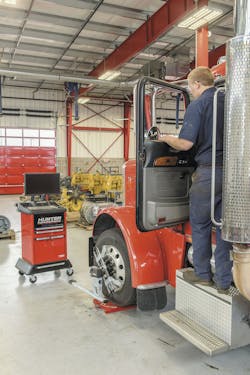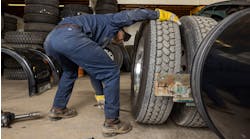Improved tire wear and better fuel efficiency are the benefits of a properly aligned commercial truck. Yet many operators neglect alignments, according to major tire equipment manufacturers who estimate that up to 70% of commercial vehicles need the service.
“It’s always been interesting to me that in the heavy-duty world we’ve got the most expensive tires, the highest number of tires per vehicle, the most weight on those tires, and the tires running the most miles, but alignment has never been in the forefront like it is in automotive,” says Don Glaser, heavy-duty alignment product manager at Hunter Engineering Co.
But technological advances have made the process of aligning a truck efficient and profitable. Manufacturers say their newest equipment is capable of checking a truck’s alignment in less than five minutes and performing the service on a 3-axle truck in as little as 30 minutes.
Simpler than cars
The installation of a heavy-duty aligner in the summer of 2015 was a big step for family-owned Tire Tread Service Inc., whose employees were mounting and dismounting truck tires by hand just 18 months earlier. The new alignment machine capped a year of heavy-duty equipment purchases at the five-bay shop in Fredericksburg, Va.
The Hunter brand aligner was the shop’s third major investment in heavy-duty service equipment in a 12-month period. Owner Chris Barnett had already bought a heavy-duty tire changer and heavy-duty balancer, also from Hunter.
Commercial services are helping Barnett combat increased retail competition, especially with two new Goodyear outlets in his market. He says he “grew into” heavy-duty alignment, adding the service in order to be a one-stop shop for his commercial customers.
Tire Tread Service was founded by Barnett’s grandfather, Isaac Bourne, in 1945. Barnett, his brother, and his parents own the shop today, with a nephew, Kyle, learning the business. Barnett’s brother, Kevin Cooper, has done passenger car alignments for 25 years. “He grew into the heavy-duty side, too,” says Barnett. “HD alignment is actually simpler than cars because there are not as many changes and variances as in cars.”
A truck alignment is possibly one of the highest-paying services a commercial dealer can perform, according to Nick McCullough. He is president of Rav America, the North American division of Ravaglioli SpA, which was acquired by Downers Grove, Ill.-based Dover Corp. in October 2016. “A properly aligned truck reduces two of a fleet’s highest operating costs: tires and fuel,” he says. “That makes alignment services for heavy-duty vehicles one of the most important and most lucrative services the commercial tire dealer can offer.”
Speedco Inc. provides quick lube and tire services for the trucking industry through a national network of 52 outlets. The Bridgestone Americas Tire Operations LLC subsidiary began piloting a heavy-duty alignment service at select locations in mid-2016 using equipment from Ravaglioli.
“In early 2016, we introduced the Heavy Duty Interstate Battery line,” says J. Downey, vice president of sales and business development at Speedco. “The addition of the free battery tests and a replacement offering was met with great enthusiasm from our fleet and owner-operator customers.”
The company wanted to build on that success and began to explore other services, according to Downey. “As we continue to look for ways to better serve our customers, the addition of alignment services helps them protect their tire investment. Our alignment service offering fits into our preventative maintenance solutions portfolio without sacrificing the speed and quality of service that our customers expect from Speedco.”
Results in minutes
Barnett expects alignment business to continue to grow at his Fredericksburg shop. He attributes a 5% boost in unit sales and revenue to his new Hunter heavy-duty aligner. Overall, his commercial business is up about 25% over the last five years. “There is a big demand for truck alignment. It’s just getting that word out to let everyone know when you didn’t do something for years and you start doing it.”
There’s another challenge for Barnett to overcome. “In my area we have a guy who’s using a 50-year-old machine, and he tells people he can do a great job when he really doesn’t. You can’t align modern vehicles with 50-year-old equipment. It’s not going to work. You can get somewhat close but it’s not nearly the accuracy or the speed you can do with the modern equipment.”
A shop using decades-old equipment is not unusual, according to Glaser.
“The really old-school guys are still using trammel bars and tape measures, which is a very archaic method. It was abandoned in the early 1970s in the automotive market but there are still quite a few heavy-duty shops where that is common alignment equipment. When we’re talking about a specification measuring down to hundredths of a degree, you can’t even dream of that kind of accuracy with that equipment.”
Modern equipment has transformed HD alignments. But the belief alignments are cumbersome, labor-intensive, and time-consuming persists.
Glaser says Hunter has applied what it learned in the automotive market to truck alignment.
“Our newest truck system will set up and give alignment readings in three-and-a-half minutes. On older systems, just to get alignment readings used to be a 20- to 25-minute process for the whole truck. If you are spending 25 minutes just to get the hardware attached and set up and ready to go, you’d better hope you sold the job before you got started,” says Glaser.
According to McCullough, the quality, usability, performance, reliability, and durability of heavy-duty alignment machines have improved tremendously.
“In the old days, you had to have some kind of a guru to perform a good wheel alignment because the equipment was lacking. The technology wasn’t there. What’s changed is the technology has improved so much an operator with less experience can get the premium results you’re looking for.”
Average alignment fees for 3-axle trucks are in the $300 to $400 range, according to McCullough. “This doesn’t even take into account the additional income from parts sales and labor sales. When you bring a vehicle in for alignment, you’re looking for worn parts and other add-on sales. With modern equipment, it’s possible to perform a truck alignment in 30 minutes. When you’re charging $300 to $400, I doubt there’s anything in the shop that pays as well.”
However, much of the equipment in dealers’ shops is dated, according to McCullough. “That means poor performance, more time required, and time is money. So we should be constantly looking for ways to improve our performance and the productivity we get out of each bay.”
MTD asked Glaser, McCullough, and Tricia Kane, marketing and sales communications manager at Bee Line Co., to explain the opportunities heavy-duty alignment service offers commercial tire shops.MTD: How is alignment is related to a fleet’s tire and fuel costs, vehicle safety, and vehicle drivability?
Bee Line: Alignment is crucial for getting the maximum service life out of a tire. Improper wheel alignment results in excessive or irregular tire wear, hard steering, poor drivability, and premature failure of suspension parts. Toe and tracking are the two most critical alignment settings for front end tire wear.
Bee Line gauging equipment incorporates lasers to measure for proper steer axle toe. Excess or too little toe will make the front wheels fight each other, thus increasing wear. An out-of-toe condition leads to rapid inside or outside wear of steer tires.
Tracking misalignment will also cause irregular tire wear in the steer tires. Tracking, or thrust, is gauged relative to the vehicle centerline. The Bee Line method uses the chassis center line as a reference to achieve optimum vehicle performance. Bee Line is a pioneer in axle correction equipment, and our exclusive equipment is a must for the truck repair facility that wants to perform complete truck alignment service. The Bee Line floating beam system and correction tooling allow the operator to fine-tune the axles to these specs.
By making cold bends, our tools enable the technician to make precise camber and caster corrections on any size axle without removing them from the vehicle. Improper camber is the third leading cause of steer tire wear.
Hunter: A proper alignment can significantly decrease tire costs and have a measurable impact on fuel costs. Often, when an alignment is ordered, only the steer axle is aligned, but bringing the loaded drive and trailer tires into proper alignment will provide greater impact on tire life and fuel economy. Since properly aligning all three axles reduces pulling and drifting, it can reduce driver fatigue and increase safety.
Rav America: Alignment has been proven to have a powerful impact on tire life, especially where steering tires are concerned. Along with improper inflation practices it is perhaps the single most significant cause of premature tire wear. Proper alignment settings have been proven to reduce rolling resistance. Lower rolling resistance means longer tire life because there is less tire scrub or scuff.MTD: How can dealers use alignment service to retain customers, and what can they expect as far as profitability?
Bee Line: Proper all-axle alignment starts with steering, suspension and frame component inspection. Seventy percent of the trucks on the road are misaligned. We already know that this affects driver comfort, fuel consumption, and tire wear. In order to build and retain customers, you need to perform a proper total vehicle wheel alignment. According to the trucking industry’s Technology and Maintenance Council’s recommended practice (TMC RP642), the ideal value for the angle formed by the centerline of the vehicle frame and the direction that an axle points is 0 degrees. This is the Bee Line method.
Proper alignment has a low cost of sale. A 3-axle alignment for around $200 takes about an hour. The parts cost is almost zero and the technician cost is only one hour. Attempts to correct alignment on a vehicle with worn or loose components are pointless. Sixty percent of trucks that need alignment have worn parts. The first step in a Bee Line alignment is suspension inspection. The parts and labor sales resulting from this initial inspection can surpass standard alignment revenue 2 to 1.
Hunter: Newer Hunter alignment systems can perform a “QuickCheck” on a 3-axle truck in less than four minutes. These checks can certainly add significantly to the bottom line of the shop, especially when you consider that approximately 70% of trucks on the road need more accurate adjustment than older methods allow.
These alignment checks can also pinpoint areas for further inspection. Often when alignment is needed, there are suspension components that are suspect and are the cause of the misalignment. Repairing these failing parts while in for a PM (preventative maintenance) can reduce costly downtime for the operator. This is an additional revenue source for the shop. On the other hand, the printout gives the operator verifiable information on the direction of travel of each wheel as it relates to the truck. This way they can make informed decisions on whether it is time to perform an alignment.
Maintaining proper alignment increases tire life, reduces wind resistance, increases fuel economy, and gives peace of mind to the operator that they are only paying for an alignment when it is actually needed. When an alignment is not needed, providing a passing printout adds credibility that the shop is honest and only charges for needed services. It’s really a win-win situation for everybody involved. Alignment service can range from $75 to $125 or more per axle depending on market and type of truck.
Rav America: FastCheck is a two- to three-minute test of the truck’s alignment condition on the steering axle. A full color graphic printout is created which becomes the documentation needed to sell the alignment service. The EZ Printout can be presented to the customer in the waiting area, or it can be emailed to the customer or to your front desk. It has been our experience that 60% to 70% of the trucks tested need alignment attention and that about half of those can be sold the alignment service. If the dealer FastChecks eight trucks per day, five of them will need alignment service, and at least two of them will purchase the alignment.
Our system allows for an ultrafast measurement of the steer axle using only two sensor heads. Since the toe on the steering axle is by far the most critical alignment angle on the truck, this service can be used to help retain customers. The dealer could offer his clients a reduced price for checking and fine-tuning the steer axle toe, thereby helping ensure the full life of the tire.MTD: What does your equipment mean to the profitability of a dealer’s alignment service offering?
Bee Line: The Bee Line LC7500 Laser Guided Computer Wheel Alignment System was developed to significantly lower the cost of performing alignments and increase productivity, therefore improving profit potential.
The LC7500 is unique because it gives the technician the ability to continually maintain the precision of all Bee Line alignment equipment. The entire system can be calibrated in a few minutes right in the shop. There is no downtime and no additional bills from service reps to maintain the accuracy of the alignment system.
Windows-based WindSpeed 7500 software has integrated help videos and service manuals that are uncomplicated and straightforward, making training simple. If more complex assistance is needed, our technology experts virtually access the machine from our headquarters to offer a solution.Hunter: The main objective of the latest generation of machines from Hunter is to increase productivity and profitability while maintaining Hunter’s strict standards of accuracy. Added benefits are that the equipment is easier to set up and has more help screens.
While these screens are useful in guiding a technician through the process, nothing can replace proper technician training. Fortunately, Hunter has training centers located across the country to ensure that maximum productivity and profit is attainable.
Rav America: FastCheck is the game changer. The top range machines will all do an acceptable alignment. The game changer, however, is the ability of our system to FastCheck the vehicle and generate alignment sales. FastCheck accurately tests the alignment condition of the vehicle’s steering axle and creates real documentation that the alignment is justified. This documentation is in the form of a highly visual and easily interpreted printout.
MTD: When is a shop’s existing alignment equipment “too old”?
Bee Line: There is no “expiration date” on alignment equipment that determines when a system is “too old,” but there definitely are some things to consider when it comes to efficiency, accuracy and productivity. Newer systems offer the benefits of advanced technologies. These technological improvements afford a faster, more precise and extremely accurate alignment. In order to maximize profitability, a shop needs to determine if their current machine can still sufficiently give them their desired results.
Hunter: It is difficult to determine when alignment equipment is “too old,” but here are a few things to think about. If the equipment routinely suffers downtime or causes productivity bottlenecks, it should be replaced. These days, if a shop owner wants to maximize profitability from his alignment space, a machine that can’t provide clear, concise alignment check printouts without significant hassle or labor should be upgraded to a model that allows for this type of service.
Rav America: If your system does not have the FastCheck capabilities then it should be replaced no matter the age. If your existing machine is fairly new you could add a standalone FastCheck test system. Another reason to replace your existing system is speed of operation. The best of the modern systems offer setup and measuring times of about 5 minutes. The best of the modern systems can perform a 3-axle alignment in as little as 30 minutes.MTD: How can dealers market heavy-duty alignment service?
Bee Line: Dealers can maximize their alignment business by selling their services through advertising in newspapers, billboards, local radio/TV, and local publications/ Yellow Pages. They may choose to run sales promotions that can include point-of-purchase displays, specialty logo advertising, trade shows, sweepstakes/contests and premiums, rebates or coupons. Direct mail promotions, news releases, and social media all greatly help to grow the business as well.
Hunter: Doing Alignment QuickChecks on trucks is a tried and true method for selling alignments. It takes under four minutes, and is very easy to do.
Rav America: There is only one way to effectively market alignment services... to FastCheck every vehicle that enters your shop and sell the alignment when it is needed. ■




